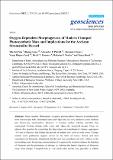| dc.contributor.author | Sim, Min Sub | |
| dc.contributor.author | Liang, Biqing | |
| dc.contributor.author | Petroff, Alexander P. | |
| dc.contributor.author | Evans, Alex J. | |
| dc.contributor.author | Klepac-Ceraj, Vanja | |
| dc.contributor.author | Flannery, David T. | |
| dc.contributor.author | Walter, Malcolm R. | |
| dc.contributor.author | Bosak, Tanja | |
| dc.date.accessioned | 2014-03-06T18:44:44Z | |
| dc.date.available | 2014-03-06T18:44:44Z | |
| dc.date.issued | 2012-10 | |
| dc.date.submitted | 2012-09 | |
| dc.identifier.issn | 2076-3263 | |
| dc.identifier.uri | http://hdl.handle.net/1721.1/85544 | |
| dc.description.abstract | Some modern filamentous oxygenic photosynthetic bacteria (cyanobacteria) form macroscopic tufts, laminated cones and ridges that are very similar to some Archean and Proterozoic stromatolites. However, it remains unclear whether microbes that constructed Archean clumps, tufts, cones and ridges also produced oxygen. Here, we address this question by examining the physiology of cyanobacterial clumps, aggregates ~0.5 mm in diameter that initiate the growth of modern mm- and cm-scale cones. Clumps contain more particulate organic carbon in the form of denser, bowed and bent cyanobacterial filaments, abandoned sheaths and non-cyanobacterial cells relative to the surrounding areas. Increasing concentrations of oxygen in the solution enhance the bending of filaments and the persistence of clumps by reducing the lateral migration of filaments away from clumps. Clumped mats in oxic media also release less glycolate, a soluble photorespiration product, and retain a larger pool of carbon in the mat. Clumping thus benefits filamentous mat builders whose incorporation of inorganic carbon is sensitive to oxygen. The morphogenetic sequence of mm-scale clumps, reticulate ridges and conical stromatolites from the 2.7 Ga Tumbiana Formation likely records similar O2-dependent behaviors, preserving currently the oldest morphological signature of oxygenated environments on Early Earth. | en_US |
| dc.description.sponsorship | United States. National Aeronautics and Space Administration (NASA Astrobiology Institute NNA08CN84A) | en_US |
| dc.description.sponsorship | National Science Foundation (U.S.) (EAR-0843358) | en_US |
| dc.language.iso | en_US | |
| dc.publisher | MDPI AG | en_US |
| dc.relation.isversionof | http://dx.doi.org/10.3390/geosciences2040235 | en_US |
| dc.rights | Creative Commons Attribution | en_US |
| dc.rights.uri | http://creativecommons.org/licenses/by/3.0/ | en_US |
| dc.source | MDPI | en_US |
| dc.title | Oxygen-Dependent Morphogenesis of Modern Clumped Photosynthetic Mats and Implications for the Archean Stromatolite Record | en_US |
| dc.type | Article | en_US |
| dc.identifier.citation | Sim, Min Sub, Biqing Liang, Alexander P. Petroff, Alexander Evans, Vanja Klepac-Ceraj, David T. Flannery, Malcolm R. Walter, and Tanja Bosak. “Oxygen-Dependent Morphogenesis of Modern Clumped Photosynthetic Mats and Implications for the Archean Stromatolite Record.” Geosciences 2, no. 4 (October 11, 2012): 235–259. | en_US |
| dc.contributor.department | Massachusetts Institute of Technology. Department of Earth, Atmospheric, and Planetary Sciences | en_US |
| dc.contributor.mitauthor | Sim, Min Sub | en_US |
| dc.contributor.mitauthor | Liang, Biqing | en_US |
| dc.contributor.mitauthor | Petroff, Alexander P. | en_US |
| dc.contributor.mitauthor | Evans, Alex J. | en_US |
| dc.contributor.mitauthor | Bosak, Tanja | en_US |
| dc.relation.journal | Geosciences | en_US |
| dc.eprint.version | Final published version | en_US |
| dc.type.uri | http://purl.org/eprint/type/JournalArticle | en_US |
| eprint.status | http://purl.org/eprint/status/PeerReviewed | en_US |
| dspace.orderedauthors | Sim, Min Sub; Liang, Biqing; Petroff, Alexander P.; Evans, Alexander; Klepac-Ceraj, Vanja; Flannery, David T.; Walter, Malcolm R.; Bosak, Tanja | en_US |
| dc.identifier.orcid | https://orcid.org/0000-0001-5179-5323 | |
| dspace.mitauthor.error | true | |
| mit.license | PUBLISHER_CC | en_US |
| mit.metadata.status | Complete | |
